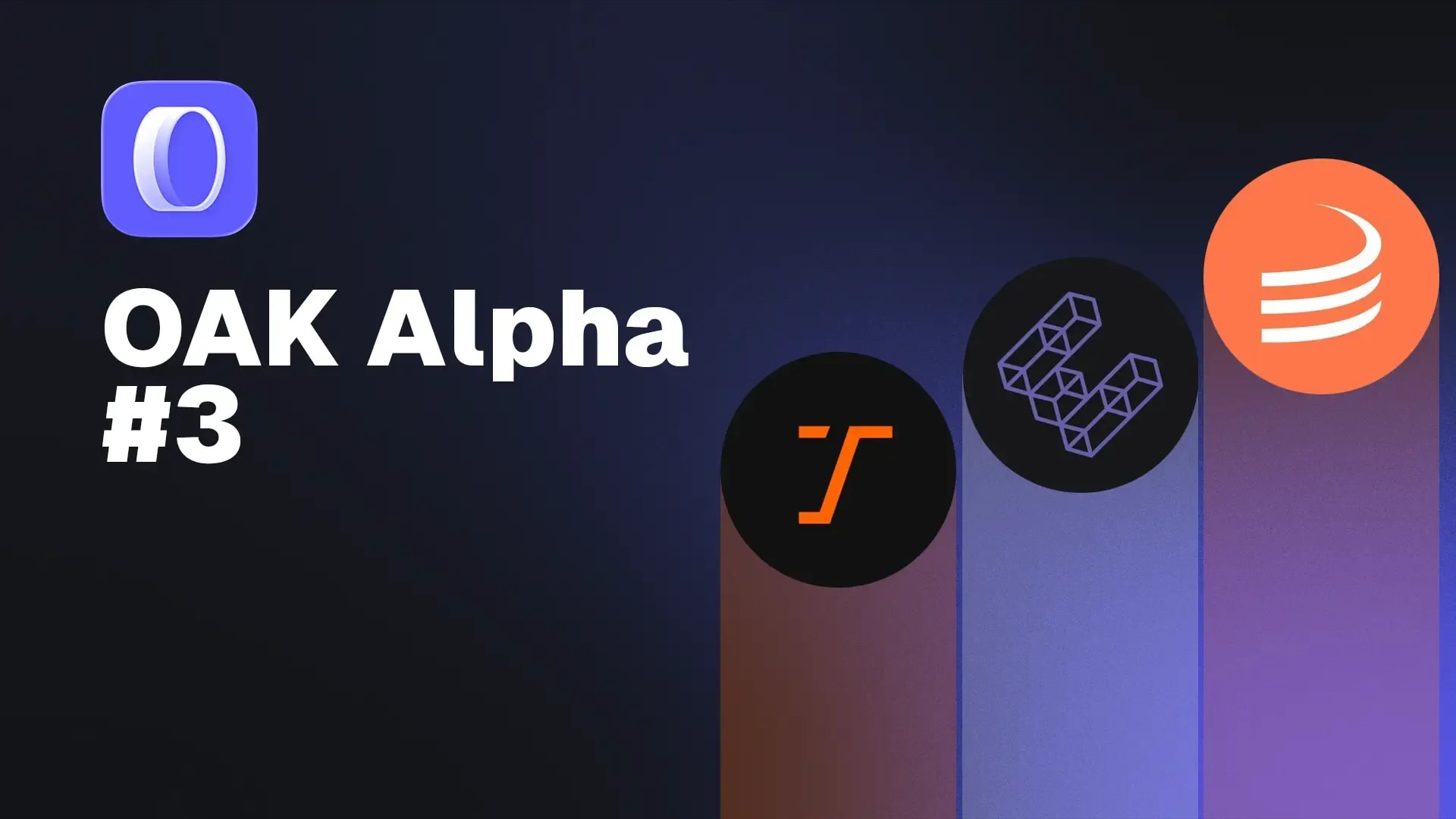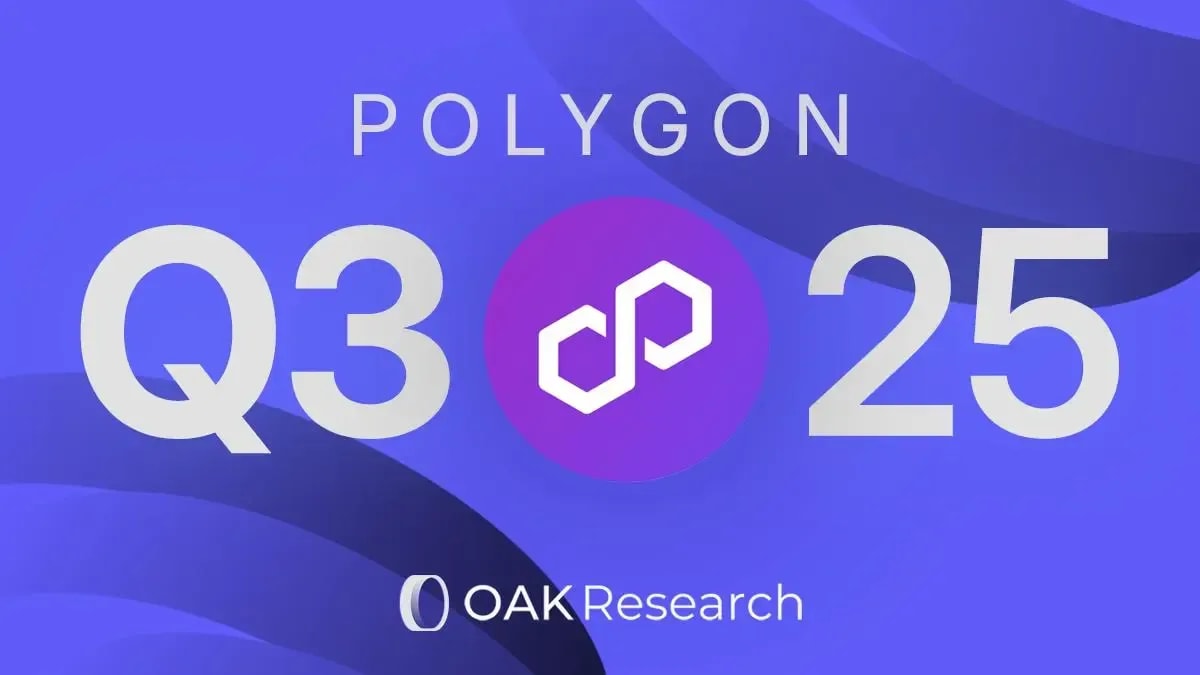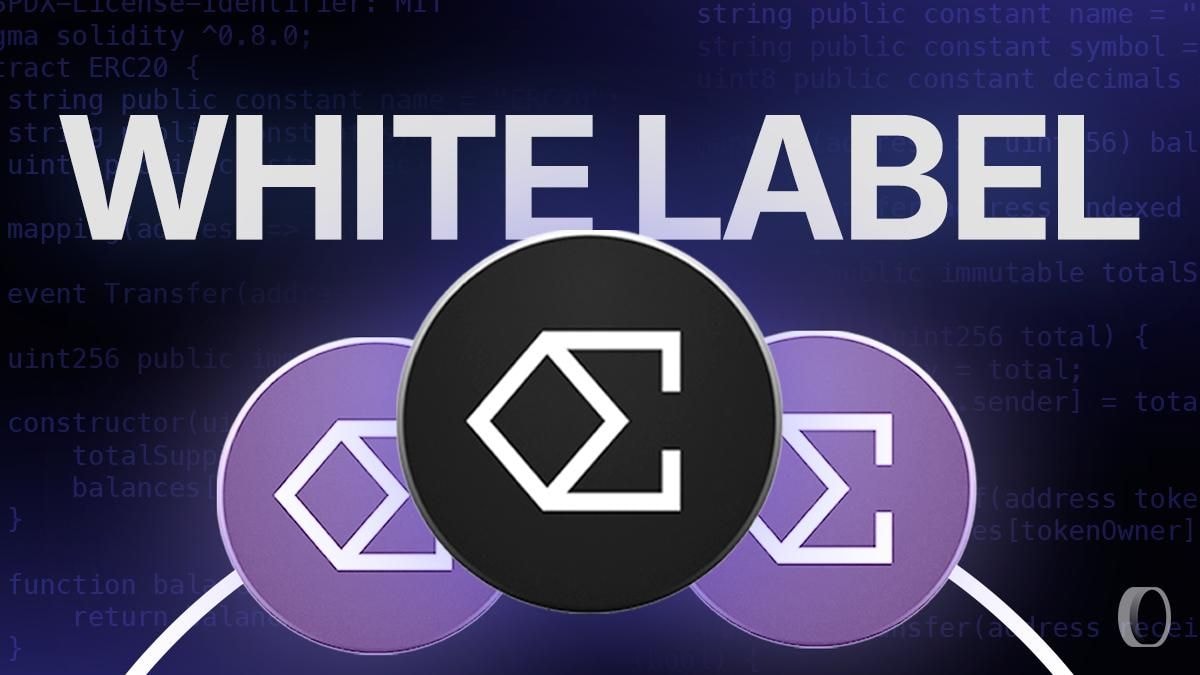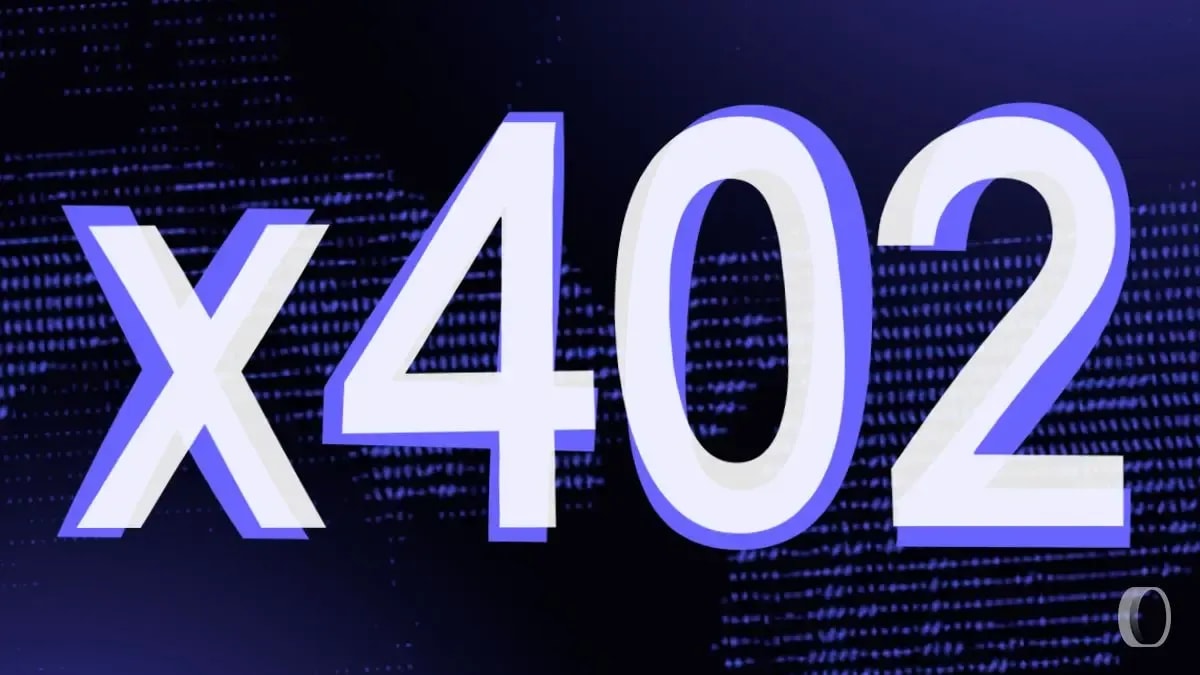Polygon (POL): S1 2025 Activity Report
August 5, 2025

Sponsored Content
This content was written as part of a commercial collaboration. Although the OAK Research team conducted a preliminary assessment of the project presented, we disclaim any liability for losses or damages resulting from decisions based on this article. Cryptocurrencies involve high risks, and this content is provided for informational purposes only and does not constitute investment advice.
In this post
In this Polygon (POL) activity report, we look at the key activity metrics: TVL, ecosystem, user activity, and stablecoin growth, as well as major developments and technical innovations in the ecosystem.
Key Highlights
- Sandeep Nailwal has taken over as CEO of Polygon, with the ambition of breathing new life into an ecosystem often seen as losing momentum.
- Polygon unveils the “Gigagas” roadmap, a technical scaling plan aiming to support 100,000 transactions per second (TPS) by 2026.
- Launch of Katana: this new layer 2, incubated by Polygon, aspires to become a liquidity hub thanks to an innovative bridge that optimizes yields by leveraging Ethereum.
- AggLayer: Polygon’s interoperability solution has undergone several major upgrades, broadening its compatibility with other stacks and reinforcing network interconnection.
Context about Polygon
Polygon is a comprehensive ecosystem of solutions dedicated to scaling Ethereum, enabling fast and low-cost transactions. Initially launched as Matic Network, the project has gradually evolved into a multi-chain infrastructure, combining various layer 2 solutions with interchain interoperability tools.
The project’s core goal is to make Ethereum a true “Internet of Value,” accessible to all and capable of supporting large-scale use cases. To achieve this, Polygon leverages a diverse range of scalability technologies while maintaining native compatibility with the Ethereum Virtual Machine (EVM), facilitating seamless integration for developers and decentralized applications (dApps).
Today, the Polygon ecosystem is structured around three main pillars:
- Polygon PoS, the original sidechain, secured by its own set of validators and POL staking, though now somewhat limited by its initial design;
- Polygon CDK (Chain Development Kit), an open-source toolkit enabling third-party projects to easily deploy their own interoperable blockchains, built on a shared standard;
- AggLayer, an aggregation protocol that synchronizes chains for a smoother user experience without sacrificing the sovereignty of each L2.
It’s also worth mentioning Polygon zkEVM, a ZK-based L2 solution providing EVM compatibility and fast finality on Ethereum. However, due to limited adoption, it was recently announced that this network will be gradually discontinued.
The POL token, which has replaced MATIC, sits at the heart of the project’s vision: it is used for staking on the PoS chain, secures the AggLayer, and enables communication across all ecosystem chains. In parallel, Polygon encourages developers and stakers to participate through a variety of incentive and grant programs using POL tokens.
In summary, Polygon now offers a coherent, multi-chain infrastructure designed to strengthen Ethereum’s scalability while limiting fragmentation across the L2 ecosystem.
→ Find our complete presentation of Polygon (POL):
Loading post...
Polygon Performance
TVL and Ecosystem
In the first half of 2025, Polygon’s TVL increased from approximately $899 million to over $1.06 billion, representing a growth of 18%. This increase is significant, especially when compared to the general DeFi TVL, which fell by 14% over the same period.

Polygon’s TVL remains far from its record levels of 2021, when the ecosystem was worth nearly $10 billion. However, it is important to note that the number of layer 2 networks has exploded since then. The main issue for Polygon is not so much its “ageing” image, but rather the real anchoring of its ecosystem: most leading applications are now multi-chain, and very few initiatives are launched natively on the network, which limits user interest.
Here is the breakdown of the main TVL per protocol on Polygon:
- Quickswap: $398 million
- Aave: $313 million
- Spiko: $142 million
- Polymarket: $113 million
- Morpho: $89 million
Other notable protocols include Uniswap ($77 million), BlackRock’s BUIDL fund ($68 million), and Fluid ($54 million). Except for Quickswap and Polymarket, most protocols are also available on many other blockchains, particularly other Ethereum layer 2s.
It is also worth noting that Quickswap is largely responsible for Polygon’s TVL growth. The protocol grew from $88 million in TVL at the beginning of the year to over $360 million at the end of the semester, a 300% increase. This is explained mainly by its positioning as a liquidity hub, following a model similar to Fluid.
Quickswap is also planning a launch on Base.
Polymarket is also an interesting case: the application managed to attract over $500 million in TVL at its peak during the US elections. However, once the event ended, the amount of stablecoins deposited quickly returned to previous levels.
Stablecoins
The stablecoin sector is clearly the big winner of 2025, and this is reflected on Polygon. Stablecoin TVL rose from $1.68 billion to over $2.4 billion in the first half of 2025, representing 45% growth-also above the sector average for the same period (+30%).

Polygon’s new “Gigagas” roadmap signals the intent to become an infrastructure facilitating payments and value exchange, notably through stablecoins.
This dynamic is fueled by new integrators such as Stripe and major fintechs, along with the multiplication of real-world use cases in payments and DeFi. Polygon thus benefits from its “utility chain” strategy, which translates into organic growth of stablecoin volumes circulating on the network.
DEX Volumes
DEX volumes on Polygon have shown relative stability over the semester, averaging around $890 million per week (vs. $1.14 billion in S2 2024). The latter figure is explained by a spike in activity at the end of 2024, driven by the US elections and the excitement around Polymarket.
Notably, Polygon now represents just 1.5% of the total volumes processed by Uniswap, illustrating the current situation: the network has lost ground to other layer 2s during the previous bear market, and the concentration of activity around a few ecosystems (especially Solana and Base) has strongly affected Polygon.
Nevertheless, Quickswap managed to rank second among Polygon DEXs by volume ($1.5 billion in June), behind Uniswap ($1.8 billion). The return of a native application, with promising technical developments, could encourage renewed user interest in Polygon.

Network Activity and Fees
During the first half of 2025, Polygon recorded an average of 22.5 million weekly transactions, a stable level compared to S2 2024 (+1.3%) but a clear decrease over a rolling twelve-month period (-19%). This stagnation comes in a more selective market environment, where only networks with strong use cases or significant incentives manage to maintain or increase activity.
Despite this stability, Polygon saw a sharp drop in fees generated: these declined by almost 50% in Q2 2025, from $1.8 million to $897,000. Thus, in S1 2025, average weekly fees were less than $85,000, compared to around $150,000 in H2 2024-a decrease of about 43%.

This drop is mainly explained by the ongoing reduction in transaction fees across all layer 2 blockchains since the implementation of EIP-4844 at the start of 2024. The introduction of blobs has reduced data publishing costs on Ethereum, making Polygon transactions more affordable than ever: the average fee fell from $0.014 in S1 2024 to $0.0082 in S2 2024, and finally to $0.0046 in H1 2025 (-43%).
Major Events
Although Polygon is still far from its historical performance, the first half of 2025 was marked by several events that will be important for the development of the ecosystem in the coming months and years.
Support for Innovation
In January, Season 2 of the Polygon Community Grants Program (CGP) was launched with an allocation of 35 million POL, nearly double the first season. This initiative aims to support high-potential projects at an early stage. Unlike other funding models, the CGP relies on a decentralized approach, with independent Grant Allocators such as Gitcoin, Eliza Labs, and Crossmint responsible for distributing funds to projects in fields such as AI, DePIN, or memecoins.
Another approach, called Direct Track, allows projects that do not fit into predefined categories to apply for a share of the 20 million POL set aside. This flexibility attracts a diverse range of initiatives, including those migrating from other blockchains.
In parallel, Polygon launched the AggLayer Breakout Program in April, a hybrid incubator for projects built around its AggLayer infrastructure. The aim is twofold: to support technically ambitious projects and to strengthen the utility of the POL token. Projects from this program plan to airdrop part of their native tokens (5 to 15%) to POL stakers to incentivize them to secure and validate AggLayer transactions.
This mechanism creates a virtuous cycle: the more projects are incubated, the more POL staking is valued, and the more the ecosystem attracts new developers. Beyond mere funding, these two programs are designed to accelerate the organic growth of Polygon by fostering the emergence of real use cases.
Strategic Partnerships
One of the highlights of the semester was the January announcement of a strategic partnership between Jio Platforms and Polygon Labs. Jio is part of a telecoms giant with more than 450 million users in India.
The goal of this partnership is to integrate Web3 features into Jio's existing apps and services, leveraging Polygon’s blockchain solutions. The collaboration aims to facilitate the creation of large-scale, user-focused Web3 services in a market where mobile access dominates digital infrastructure.
For Polygon, this partnership positions it as a reference player in the sector while providing access to a broader, more international user base. For Jio, it serves as a lever for innovation to enrich its ecosystem and create new digital use cases.
Separately, Stripe announced in early 2025 the integration of the Polygon network for stablecoin payments. This allows users of certain Stripe partner platforms to receive or make instant USDC payments via Polygon, with minimal fees. This move reinforces Polygon’s ambition to become a preferred infrastructure for digital payments.
Despite Polygon's loss of momentum, these two initiatives demonstrate the growing interest of major players in its technical solutions.
Miden Raises $25 Million
Among the projects incubated through the AggLayer Breakout Program, Miden stands out for its technical ambition and a recent $25 million fundraising round announced in April. Led by a16z crypto, 1kx, and Hack VC, this marks a key step in developing what the team calls an “edge blockchain.”
Miden is working on an architecture that shifts execution and state maintenance to users. The goal is to enable public and private institutions to process large, confidential transactions while remaining compliant with prevailing regulations. This infrastructure is based on ZK technology.
Still in the testnet phase, the project is expected to launch its mainnet during the year. As part of the AggLayer program, around 10% of tokens should be distributed as an airdrop to POL stakers.
New CEO and Strategic Shift
In June 2025, Sandeep Nailwal, co-founder of Polygon, took over sole leadership following the departure of Mihailo Bjelic. He quickly laid the foundations for a major strategic pivot: refocusing on high-performing pillars of the ecosystem, developing the technical stack, and setting new ambitions for the POL token.
- Phasing Out zkEVM
The most notable announcement concerns the gradual discontinuation of zkEVM, considered too complex to maintain, insufficiently differentiated in a saturated ZK market, and misaligned with the team’s new priorities. The end of the mainnet beta is scheduled for 2026.
- Refocusing on Polygon PoS and AggLayer
Polygon is now concentrating its efforts on two main axes: the historical Polygon PoS chain, undergoing a technical overhaul, and AggLayer, the interoperability layer connecting the ecosystem's chains.
Nailwal stated his intention to return to a startup mindset. Under his leadership, Polygon is expected to enter a phase of rapid innovation aligned with current market demands.
- The “Gigagas” Roadmap
The name is evocative: Polygon now aims for 100,000 TPS with instant finality, stable fees, and institutional compatibility. This scale-up will occur in stages:
- July 2025: 1,000 TPS on mainnet, 5-second finality, and gas system overhaul;
- October 2025: 5,000+ TPS on mainnet, block-by-block finality and AggLayer integration into Polygon PoS for optimized liquidity;
- 2026 and beyond: surpassing 100,000 TPS, increased institutional adoption, and development of stablecoin use cases.
This repositioning is accompanied by the return of major market makers after the SEC dropped the case against the MATIC token. This should boost liquidity and trading on the network, which now aims to become the number one blockchain for institutional use and stablecoin transfers.
→ Find our complete presentation of Polygon (POL):
Loading post...
Major Technical Improvements
During the first half of 2025, Polygon’s ecosystem underwent several major technical upgrades, contributing to the implementation of the Gigagas roadmap.
AggLayer Becomes Multistack and More Secure
As mentioned earlier, AggLayer is a foundational pillar of Polygon’s future ecosystem. Its protocol unifies chains and allows them to communicate seamlessly.
Two major updates occurred in 2025: the integration of pessimistic proofs and the ability to support chains from other technical stacks.
Until now, only chains built with Polygon CDK could connect to AggLayer. With the introduction of pessimistic proofs, AggLayer becomes compatible with all sorts of blockchains using different security mechanisms (ZK, optimistic, etc.).
The idea behind pessimistic proofs is to assume all chains can potentially cheat. AggLayer therefore imposes strict rules: each chain must prove it is not withdrawing more funds than it has received. In the event of fraud, a chain can be isolated without affecting others.
This approach guarantees reliable communication even in an environment where some chains are more secure than others. This is a major paradigm shift compared to the traditional model where the security of the whole is limited by the weakest link.
Adding pessimistic proofs enables AggLayer to become truly multistack. Polygon has opened its CDK with a first integration of OP Stack, allowing developers to create L2s based on Optimism technology while maintaining native compatibility with AggLayer.
This is a major step forward, as it is no longer necessary to use only Polygon technology to be integrated into the ecosystem. This lowers the barrier to entry for project creators, who can benefit from Polygon’s advantages without restrictions.
These two upgrades solidify Polygon’s ambition to create an interoperable, seamless, and secure Web3.
Launch of L2 Katana
To fully deploy AggLayer’s potential, significant and accessible liquidity is essential. That is precisely the mission of Katana, a new DeFi chain designed from the start to maximize yield and liquidity depth within the Polygon ecosystem.
Katana’s goal is to become a hub concentrating liquidity within a few core dApps: Sushi for trading, Morpho for lending, and Vertex for perpetual trading. Thanks to AggLayer, this liquidity can then benefit all connected chains, enabling the creation of interchain dApps.
For example: a user wants to swap ETH for token X on a chain lacking liquidity. The swap goes through AggLayer and is executed on Katana before being returned to the original chain.
To create this liquidity hub, Katana relies on several pillars:
- Vault Bridge
Each new chain needs a bridge to allow deposits. The Vault Bridge differs from others: assets placed in the bridge are put to work in different protocols on Ethereum using conservative, proven strategies. The yield generated is then sent to Katana’s core dApps and distributed to users. This approach, while riskier, allows Katana to offer higher yields than competitors and thus attract liquidity.
Even during market downturns, this technique enables Katana to offer more viable returns than chains that rely only on token emissions.
- The AUSD Stablecoin
AUSD is Katana’s native stablecoin, backed by US Treasury bonds. The yield generated by these underlying assets is also distributed to Katana’s core dApps, further reinforcing the sustainability of returns for users.
- Chain Owned Liquidity
Chain Owned Liquidity (CoL) refers to liquidity controlled directly by the chain and allocated to core dApps. CoL will be funded by 100% of the sequencer’s revenues, gradually strengthening the network’s liquidity.
Thus, the more Katana is used, the more fees are generated, and the greater the chain’s liquidity.
- uAssets
A fourth pillar: uAssets, representing non-EVM assets bridged to Katana (XRP, SOL, DOGE, SUI, etc.). These tokens are collateralized by their equivalents at Coinbase Prime Custody, giving Katana additional status as a hub for exchanging both EVM and non-EVM assets.
Thanks to these pillars and AggLayer, Katana could, in the coming years, become a true DeFi crossroads, facilitating cross-chain and cross-asset swaps and providing liquidity to aggregators.
For now, there is still a long way to go. Katana launched just a month ago and, although its TVL already exceeds $270 million, this remains modest compared to leading chains.
Because even if Katana improves liquidity for AggLayer-connected chains, its yield model is based on using assets on both L1 and L2, which involves non-negligible risks even with so-called prudent strategies. It is important to be aware of this before depositing funds on Katana.
- Governance
Katana also introduces the KAT token, primarily for governance purposes.
This token is inspired by the Curve model: it can be locked as vKAT to vote in each epoch (one week) on how KAT incentives are allocated among protocols. In return, stakers receive a share of the fees generated by dApps.
While this model may seem attractive on paper, it is similar to the one launched by Berachain last February. Without real adoption, such token emission mechanisms struggle to attract lasting liquidity from investors.
The (3,3) model has been repeated many times, always with similar results: the token’s value tends to erode over time as it becomes increasingly diluted. It is therefore surprising to see this concept so often reused despite numerous precedents.
July 2025 Updates
This report stops at the end of June, but it is worth mentioning two major updates that occurred in July.
This month, Polygon reached an important technological milestone with two significant upgrades. The Bhilai hard fork increased Polygon PoS’s capacity to over 1,000 TPS while maintaining low, stable fees. It also introduced support for EIP-7702 for account abstraction, improving the user experience-for example, by allowing gas sponsorship.
As for Heimdall v2, activated soon after, it reduced block finality to 5 seconds while preparing the way for the 5,000+ TPS expected by the end of the year. Barely a month after its announcement, the first step of the Gigagas roadmap is already in place.
In the coming months, other major updates are planned, including the integration of Polygon PoS with AggLayer, which will pave the way for more efficient liquidity sharing between Katana and Polygon.
Conclusion
After a period of uncertainty, during which Polygon sometimes seemed to be spreading itself too thin across too many initiatives, the project now appears to have found a clear direction. The arrival of Sandeep Nailwal at the head of the foundation has marked a turning point, with stronger governance and a roadmap refocused on a few core pillars: the development of stablecoins and payments, scaling up via Gigagas, chain unification through AggLayer, and the targeted incubation of projects such as Katana.
Polygon now aims to regain its status as a key component of the Ethereum ecosystem. Time will tell if this new momentum lives up to its promise.





